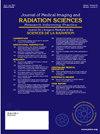用于区分病情进展和治疗反应的定量易感性图谱:三维伪连续动脉自旋标记灌注的附加价值
IF 1.3
Q3 RADIOLOGY, NUCLEAR MEDICINE & MEDICAL IMAGING
Journal of Medical Imaging and Radiation Sciences
Pub Date : 2024-10-01
DOI:10.1016/j.jmir.2024.101519
引用次数: 0
摘要
目的 评估定量易感性图谱(QSM)、三维伪连续动脉自旋标记(3D-PCASL)成像和弥散加权成像(DWI)在区分真性进展(TP)和治疗反应(TR)方面的诊断价值。所有患者均接受了包括常规 MRI、QSM、3D-PCASL 和 DWI 序列在内的检查。随访6个月或再次手术的纵向磁共振成像用于确定诊断。我们计算了增强病灶(proQSM)在幅值图像上的出血灶比例,以及 QSM 图像上相应的平均磁感应强度值(SUS)。通过放置 3-5 个圆形 ROI,测量 ASL 获得的最大脑血流量(CBFmax)和 DWI 产生的最小 ADC 值(ADCmin),并进行接收器操作特征(ROC)分析以评估诊断性能。TP的proQSM明显低于TR(0.060 vs. 0.270; p<0.001),TP的rCBFmax明显高于TR(2.180 vs. 1.265; p<0.001),TP的rADCmin低于TR(1.229 vs. 1.432; p<0.05),ROC曲线下面积(AUC)分别为0.891、0.854和0.662。结合诊断效率最高的两个参数(proQSM_rCBF 参数),AUC 达到 0.952,灵敏度达到 88.9%,特异度达到 93.3%。此外,proQSM 与 rCBFmax 存在密切的负相关(rs=-0.492;p=0.004)。结合 QSM 和 ASL 可以提高诊断效果。本文章由计算机程序翻译,如有差异,请以英文原文为准。
Quantitative Susceptibility Mapping for Distinguishing Progression from Treatment Response: Added Value to 3D Pseudo-continuous Arterial Spin Labelling Perfusion
Purpose
To assess the diagnostic value of quantitative susceptibility mapping(QSM), 3D pseudo-continuous arterial spin labeling(3D-PCASL) imaging and diffusion-weighted imaging(DWI) in distinguishing true progression(TP) from treatment response(TR).
Methods
45 patients with glioblastoma(GBM) who showed newly appearing enhancing lesions after treatment were enrolled. All underwent examination including conventional MRI, QSM, 3D-PcASL and DWI sequences. Longitudinal MRI for 6 months follow-up or repeat surgery were used to define the diagnosis. We calculated the proportion of hemorrhagic foci for the enhancing-lesions (proQSM) on magnitude image and corresponding average magnetic susceptibility value(SUS) on QSM image. The maximum cerebral blood flow (CBFmax) obtained from ASL and minimum ADC value(ADCmin) generated from DWI were measured by placing 3–5 circular ROIs, receiver-operating characteristic(ROC) analyses were conducted to evaluate diagnostic performance.
Results
28 patients were finally diagnosed with TP, and 17 patients were diagnosed with TR. The proQSM in the TP was significantly lower than in the TR(0.060 vs. 0.270; p<0.001), The rCBFmax were significantly higher in TP(2.180 vs. 1.265; p<0.001), and the rADCmin in the TP was lower than TR (1.229 vs. 1.432; p<0.05), with the area under the ROC curve (AUCs) of 0.891, 0.854 and 0.662, respectively. Combining the two parameters with the highest diagnostic efficiency (proQSM_rCBF parameter), AUC can reach 0.952, the sensitivity can reach 88.9%, and the specificity can reach 93.3%. Besides, there was a close negative correlation between proQSM and rCBFmax(rs=-0.492; p=0.004).
Conclusion
QSM can be used as an imaging biomarker for distinguishing TP and TR. Combining the QSM and ASL can improve diagnostic performance.
求助全文
通过发布文献求助,成功后即可免费获取论文全文。
去求助
来源期刊

Journal of Medical Imaging and Radiation Sciences
RADIOLOGY, NUCLEAR MEDICINE & MEDICAL IMAGING-
CiteScore
2.30
自引率
11.10%
发文量
231
审稿时长
53 days
期刊介绍:
Journal of Medical Imaging and Radiation Sciences is the official peer-reviewed journal of the Canadian Association of Medical Radiation Technologists. This journal is published four times a year and is circulated to approximately 11,000 medical radiation technologists, libraries and radiology departments throughout Canada, the United States and overseas. The Journal publishes articles on recent research, new technology and techniques, professional practices, technologists viewpoints as well as relevant book reviews.
 求助内容:
求助内容: 应助结果提醒方式:
应助结果提醒方式:


